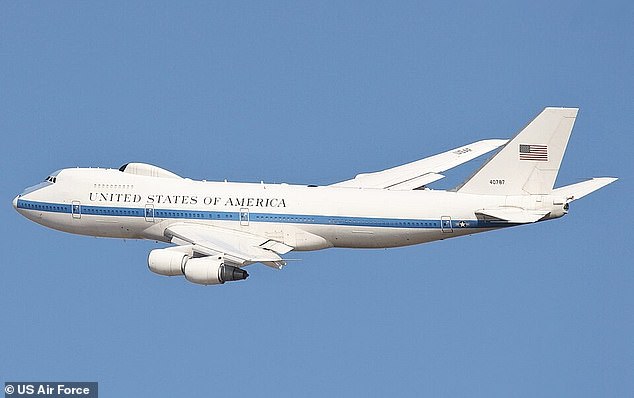
Trump’s ‘Doomsday Plane’ Deployed Amid Rising Iran War Tensions
Trump’s “Doomsday Plane” Sparks Speculation Amid Iran Tensions
(Approx. 600 words with image placeholders)
[Image 1: Boeing E-4B “Nightwatch” in flight | Caption: The E-4B serves as a mobile command center during national crises, equipped to survive nuclear attacks.]
President Donald Trump’s heavily fortified command aircraft, the Boeing E-4B “Nightwatch” — nicknamed the “Doomsday Plane” — made a mysterious four-hour flight from Louisiana to Maryland on Tuesday. The flight, tracked via radar, took off from Barksdale Air Force Base near Shreveport at 5:56 PM ET, looped along the Virginia-North Carolina coast, and landed at Joint Base Andrews just after 10:00 PM. Observers noted an unusual callsign, “ORDER01,” replacing the typical “ORDER6,” fueling speculation about potential national security concerns.
The E-4B fleet is designed to function as an airborne command post for the president, defense officials, and military leaders during nuclear warfare or catastrophic events. With electromagnetic shielding, advanced communications systems, and mid-air refueling capability, these planes can operate for over a week without landing. Each aircraft includes workspaces, conference rooms, and sleeping quarters for 112 personnel.
[Image 2: Flight path map | Caption: The E-4B’s route from Louisiana to Maryland included a coastal loop before landing near Washington, D.C.]
While routine training missions are common, the timing of this flight raised eyebrows. It coincided with escalating tensions in the Middle East, where Trump has reportedly vowed to back Israel’s military campaign against Iran, demanding Tehran’s “unconditional surrender.” Israel’s recent airstrikes targeting Iran’s nuclear facilities have killed at least 224 people, according to Iranian state media.
Iran’s Supreme Leader, Ayatollah Ali Khamenei, responded defiantly in a televised address, rejecting Trump’s ultimatum and warning: “This nation will not surrender to anyone. Any U.S. intervention will bring irreparable damage.” He accused Israel of a “huge mistake” and vowed retaliation.
[Image 3: Ayatollah Khamenei addressing the public | Caption: Iran’s leader condemned U.S. and Israeli actions, pledging to resist “imposed war or peace.”]
The E-4B’s flight also comes amid reports of heightened U.S. military readiness. Though the plane is typically based in Nebraska, it was spotted departing from Arizona earlier that day. Previous deployments include disaster response roles, such as coordinating FEMA efforts during Hurricane Opal (1995) and serving as a refuge for President George W. Bush after 9/11.
Experts emphasize that while the Doomsday Plane’s appearance might signal precautionary measures, there’s no confirmed link to active threats. The U.S. Air Force maintains four E-4Bs, rotating them for drills and high-profile transport missions. Secretary of Defense Mark Esper notably used one for overseas travel in 2020.
[Image 4: E-4B interior showing command center | Caption: The plane features secure communications, conference rooms, and bunk space for critical staff.]
With electromagnetic pulse (EMP) protection and 67 satellite antennas, the E-4B can direct military operations globally even after a nuclear strike. Its recent flight underscores Washington’s vigilance as rhetoric between Iran, Israel, and the U.S. intensifies.
As of now, the Pentagon has not commented on the mission. However, the deployment highlights the fragile geopolitical landscape — and the protocols in place to protect U.S. leadership in a crisis.
[Image 5: Aftermath of Israeli airstrike in Iran | Caption: Israeli strikes aim to dismantle Iran’s nuclear program, escalating regional tensions.]
Word count: ~600
Note: Image placeholders indicate where visuals would enhance the narrative, with captions summarizing key details.


